MARKETING
How to Run A Content Audit in 2022

As a marketer, how often do you run content audits? How do you keep track of how content is performing? Do you use those metrics to improve future campaigns?
If you’re missing this kind of organization for your company, consider investing in a content audit. They are an excellent planning resource and roadmap for future content creation. They also help you organize your analytics so you can refer back to high-performing posts if needed.
In this post, learn how you can perform a content audit for your own business, and discover high-quality tools to help you streamline the process. Keep reading, or use one of the links below to jump ahead to the section you’re looking for:
What is a content audit?
A content audit describes the process of collecting and analyzing assets on a website, such as landing pages or blog posts. Content audits keep an inventory of a website and provide insight into which content to create, update, re-write, or delete.
Content Audit Goals
Running a content audit for your website can boost your traffic and improve the experience of your readers.
First, content audits help you take note of the areas on your website that aren’t properly optimized for search engine rank. For example, you might add meta descriptions to your blog posts as part of your current strategy, but if that always wasn’t the case, a content audit helps you locate which posts need to be updated.
Content audits also help you find new SEO opportunities for your website. For example, did you know that adding keywords to the headings on your site gives search engines more clues about what your web page is about?
If search engines have as much knowledge as possible about the content on your website, they’ll be able to suggest your web pages to browsers more accurately.
Running an audit is a chance for you to update the content on your website to improve the comprehension of your site by readers. For example, you might not know the links on one of your product pages are broken, but a content audit provides you with a reminder to update those links. Let’s discuss some additional benefits below.
Benefits of Content Audits
Your content audit should help you bring your content up-to-date, improve the rank of your web pages, and make the website you present to readers easy to navigate and free of error. In addition, content audits:
- Give data-driven insight into the performance of your content, helping you make informed decisions based on factual information rather than just assumptions.
- Identify areas for content repurposing or updating where numbers are lower than desired.
- Highlight pieces of content that perform best that you can leverage in marketing materials.
- Understand more about what your audience likes and dislikes.
- Content maintenance becomes easier when you have an understanding of what you’re offering.
To make sure your website content audit is valuable, carve out enough time to complete it. However, you don’t have to be in it alone — there are plenty of templates to guide you through a content audit if you’re unsure of where to start.
Content Audit Template
To show you how a template can speed up the content audit process, let’s walk through HubSpot’s SEO Audit kit. It includes three useful tools:
- How to Run an SEO Audit guide
- On-page SEO template
- SEO audit checklist
The guide is a comprehensive overview of SEO audit principles and factors. It’s a great resource for both beginners and experienced content marketers looking for a refresher.
Next, to begin your content audit, open the on-page SEO template. This template guides you through checking the on-page SEO of your website.
The template has 16 sections, with instructions for each section.
Under each section, the template helps you understand what to look for and why it matters for on-page optimization. For example, if you note that you have multiple similar pages, the canonical tags section will help you make sure they’re grouped together.
Below, we’ll talk about the sections of the template.
Page Type
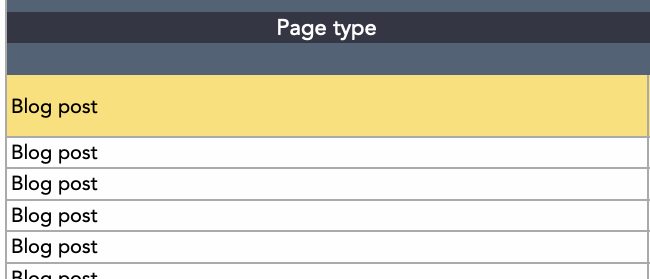
In the first column, you’ll specify your page type for each page you’re auditing. It works for many page types, like a home page, landing page, blog post, or even a form page.
URL

Then, you’ll fill in the URL.
Canonical Tags
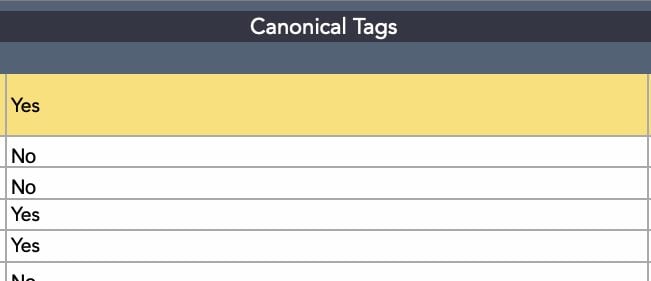
Next, note any canonical tags your site may have. Remember, you can find canonical tags in your page’s source code.
Pagination

After that, you’ll note if your page is a part of a sequence of pages to ensure that your code is properly formatted for sequencing.
Page Title

Next up, you’ll fill in some details about the page’s copy. For instance, the page title. If I included a blog post similar to this one in the audit, for example, I would put “How to Run an SEO Content Audit” in this section.
This section makes sure you’ll have keywords in your page title, boosting SERP rank.
Page Purpose
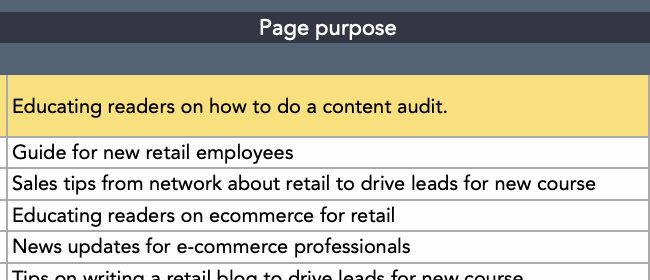
In this section, you’ll define the goal of each page.
So, for this blog post, I would define the purpose of this post in a short and descriptive sentence. For example, “Educating readers about how to do a content audit.”
Focus Keywords

Then I’d note the focus keywords of that page. My keywords for this post would be something akin to “On-Page SEO,” and “Content Audits.”
Headlines
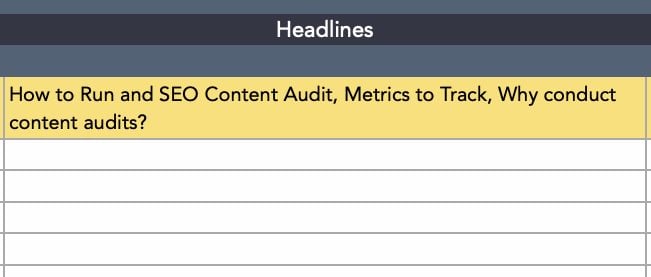
After that, you’ll note the headlines or title tags on your page. A good rule of thumb is to make sure at least one keyword appears in an H2 to help your rank.
Meta Descriptions
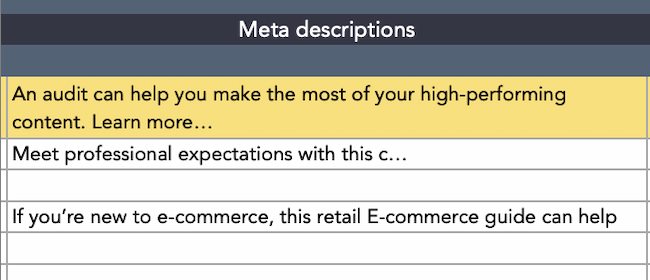
Take the same approach with meta descriptions. Add a short, concise description of your content. It should also contain a keyword to improve rank.
Images

Once you outline your headings and include your meta description, then you’ll focus on images. First, include the file name of your image and note the alt text. Recall that alt text tells Google what your image is about, so if your images don’t have any, this is a good reminder to add them.
Internal and Outbound Links
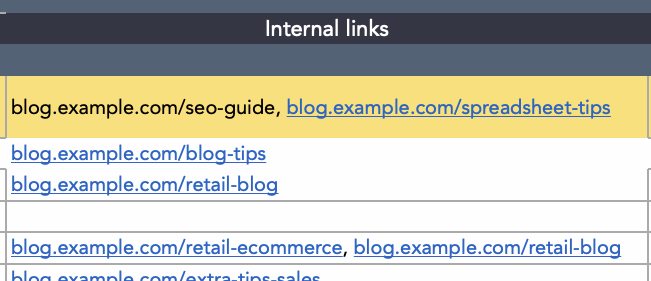
Next, you’re going to focus on links: internal and outbound. Remove broken internal links, and make sure your page has at least two or three. Remember, internal links help you to boost the traffic of other pages.
Page Speed
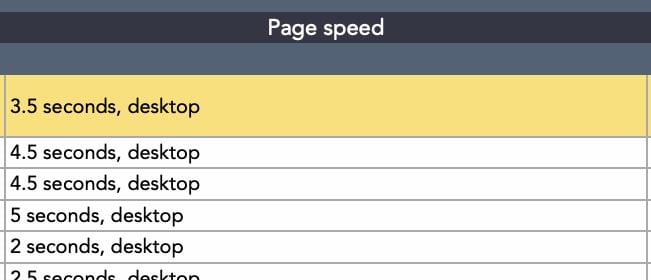
Following your link optimization, note the page speed. If your page takes longer than two seconds to load, it might not keep the reader’s attention.
Social Sharing
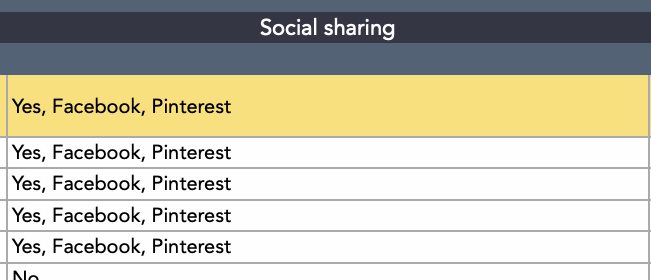
Next, make sure your page is available for sharing on social media.
Content

Review the contents of your page, paying special attention to the length of your copy and where and how you’re using keywords. This is also a chance to check for duplicate or similar content.
Mobile-friendly

Finally, check your page on mobile devices. This can help improve the accessibility of your webpage.
Once you’ve entered these details in your template, you’ll get a clear picture of what you can do to optimize your page. As you add more pages to the template, you may start to notice issues that come up repeatedly or holes in your content strategy.
For example, the “Images” section above shows that several posts are missing images and alt text. For those that have alt text, the copy isn’t optimized for some focus keywords.
This content audit data can help you form a data-driven foundation for strategy updates and recommendations.
Content Audit Spreadsheet
The SEO audit kit also offers a spreadsheet checklist. The SEO Audit Checklist helps you make sure the content of your website is fully optimized and up-to-date.
So, the template helps you update the on-page SEO of your website, while the checklist gives you an in-depth reference for running the audit.

This sheet will cue you on what to look for as you audit your site. It includes the following sections:
- Crawling and indexing audit
- On-page elements
- Ranking factors
- Content evaluation
- Link structure
- Status codes
- Scripts and coding
- Internationalization
These sections can help you understand what to look for as you audit your site. To use these checklists, you’ll simply mark “Yes” or “No” for each task, and add any notes to inform your action items.
How to Run a Content Audit
While a template can be extremely useful when auditing your content, each audit is unique, and many will use templates as a guide to create a more personalized process over time. The steps below can help you create a custom process to reach your content goals.
1. Think of your goals.
First, think about what you want to accomplish. When you have your goals in mind, you will have a better idea of how to categorize your audit later.
For example, if your goal is to increase brand awareness, you might audit your content with the goal of increasing branded keywords. Other goals to consider could be figuring out which pages need to be SEO-optimized or finding the best-performing website content to place on your homepage or in your email newsletters.
Ultimately, a content audit identifies engaging content for your audience. It can also include information on SEO and conversion rates. This process will help you see the strengths and weaknesses of your content and workflow.
Leading with company goals will ensure your content audit is useful for tracking and updating your strategy with improved tactics. After this is complete, then it’s time to collect your content.
2. Gather your content and create an inventory.
Which content are you going to audit? Content audits might include product descriptions, blog posts, video media, or online publications. Decide which content you want to audit and gather the backlog of that content.
Pulling your content together in an organized spreadsheet will create a content inventory. This will make it easier to track changes and goals for your content.
To start, collect URLs and other page information for the web pages you’ve chosen to audit. Page details you may want to collect to begin your audit include:
- Page title
- Content type
- Content format
- Word count
- Date last modified
- Linked CTAs
A content audit template can help you quickly pull together a content inventory to begin your audit. There are also online tools to help you collect this data, like SEMrush, Screaming Frog, and HubSpot.
Some tools will provide this information based on your sitemap. A site map is a file that has all your website’s information. You can usually create your sitemap for free online. For more information on this, check out this sitemaps guide.
3. Categorize your content.
After you gather your content, categorize it on the spreadsheet. Tracking every metric for every piece of content can get overwhelming quickly. So, use your goals to guide the categories you track for your audit.
Think of categories that offer useful insights from different pieces of content. For example, an SEO audit focuses on metrics like keywords, page speed, and backlinks. But if you’re running a content conversion audit, you may want to focus on traffic, click rate, and different types of conversions.
Some online tools will include metrics in audit data as well. Tools like Google Analytics can help you pull this data. Metrics can add value and context to your analysis.
Some online tools can categorize the information for you, but it’s often helpful to do it yourself. Adding relevant categories will keep you organized so your content audit meets your needs.
It can be tempting to add and remove categories throughout the process, but this can give you more data than you’re able to analyze. It’s also easy to start analyzing data before you’ve finished categorizing.
But these habits can also make the process more complex and time-consuming. They can also lead to hasty and incorrect analysis. If you notice interesting or surprising data, take a quick note, but keep categorizing before you start your analysis.
In this step, your goal is to complete a spreadsheet with the categories of data that you need to audit your content toward a specific goal.
4. Analyze your data.
Now, it’s time to look at your data critically. This is the step that will give you a good measure of the state of your content. When analyzing your data, here are some things to take note of:
- Content that’s missing — What is your audience interested in that you haven’t covered?
- Content that’s underperforming — Which pieces of content aren’t getting the numbers you want?
- Outdated content — If you have old content, can you update or rework it for optimization?
- Top content — Content that has performed extremely well.
Based on the results of this analysis, organize them in the spreadsheet. A way to do this is to assign different colors based on what you’re analyzing. Then, highlight the rows with those colors so you have an idea of which category is which. This can help you see which content takes up the largest part of your content library.
It’s also a good idea to scan your results for patterns, trends, and connections that can be hard to see when you’re looking at standard reports.
- Are there outlier posts whose performance exceeds expectations?
- Are there new topics that are getting more attention than they did a few months ago?
- Have organic backlinks spiked for specific content?
This information can help you recognize some of the happy accidents that are impacting your content performance. You can use this data to expand these ideas into your content strategy and tactics.
5. Create action items.
In this step, you will finalize and clean up your audit. You now know what to focus on based on the analysis and can go from there. Think about the posts to delete, update, re-write, or re-structure.
To organize these action items, add one last column to the spreadsheet — one that’s close to the front so you can keep tabs on it. This column will let you know the action to take on a specific URL. For example, are you going to keep, update, delete, or re-write that blog post?
If you plan on ranking by priority or including a timeline for this audit, now would be the time to include that. Some organizations use editorial calendars, while others choose a more casual approach.
To make a priority timeline that fits best with your content audit, think back to your initial goals and rank the items you want to execute first.
Keep this list of action items top of mind. That way your next content audit will show clear progress toward your goals, based on the data you found during your audit.
Content Audit Checklist
The graphic below is a checklist you can use to make sure you’re on the right track when performing your content audit.

Now, let’s go over some content audit tools you can use to further automate your content audit process.
Content Audit Tools
- Screaming Frog
- Ahrefs
- SEMrush
- Google Search Console
- Google Analytics
- WooRank
- Google Sheets
- Casted
- Vidyard
While not a requirement, choosing a content auditing tool can help you with your process. Rather than gathering URLs manually, the tool can automatically aggregate the content you’re looking for and display metrics for you to see.
But the most significant value of content audit tools is that they are fast, helping you save a considerable amount of time.
SEO Tools
1. Screaming Frog
Price: First 500 links free, unlimited for $209/year

Screaming Frog is a website crawler. It collects URLs from your sitemap and creates an SEO audit list for you. If you have a smaller site, Screaming Frog can audit up to 500 URLs for free.
The desktop Screaming Frog website is great because it provides a ton of analysis about your website and categorizes it for you.
2. Ahrefs
Price: Pricing for this tool starts at $99/month and they offer Lite, Standard, Advanced, and Enterprise plans.
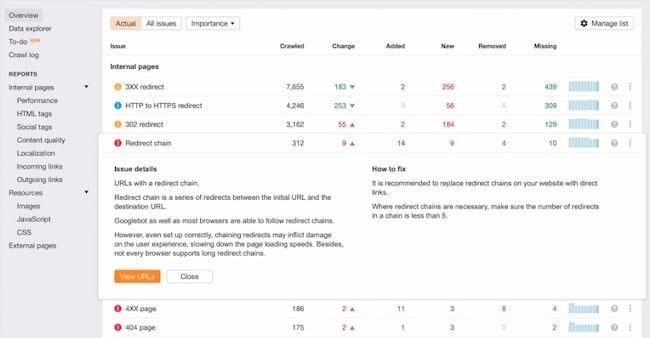
Ahrefs makes it simple to track your SEO site performance. It also offers powerful tools for keyword research, competitor analysis, and backlink tracking. You can export specific reports or track URLs, SEO performance, or groups of keywords with this useful audit tool.
3. SEMrush
Price: Free trial, then $120-$450/month
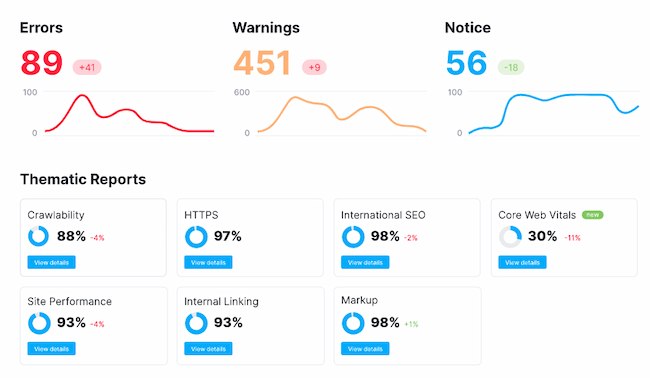
In three steps, users of SEMrush can receive a robust audit. By putting in the desired domain, you’ll get a customized report that shows you where you can improve your site:
From there, you can connect an analytics tool account, like Google Analytics. This can help if you want to see more information about your sitemap, like posts that are the most engaging for your audience. You can use this information when developing a strategy. It can help you find content that performs well for your audience.
4. Google Search Console
Price: Free

This tool makes it easy to track and analyze your website and search data. You can manually confirm that each page of your site is indexed and track URLs for useful data. The mobile usability issues features are also helpful during a content audit. You can also connect this tool to Google Analytics for more SEO insights.
Learn more about how to use Google Search Console with this useful post.
5. Google Analytics
Price: Free, with paid premium options

Google Analytics doesn’t give you a traditional audit, but it provides good information to help formulate your audit. It lets you know who is visiting your website, and from where. It also gives a rundown on the behaviors of your visitors:
Google is sunsetting Universal Analytics in 2023. The new version of this tool, called G4, uses data to predict user behavior and give you a clearer picture of your buyer journey.
It’s also important to know that Google Analytics creates reports with samples of your data, not exact data. This means that numbers on this tool may not match the numbers you may see in other content auditing tools.
Note: Another free Google tool, PageSpeed Insights, is a great way to track page speed on mobile and desktop devices.
6. WooRank
Price: Pricing for this tool starts at $80/month and they offer Pro, Premium, and Enterprise plans.

WooRank has two amazing features for content auditing: SEO monitoring and Site Crawler. SEO Monitoring from WooRank lets you know the performance of your landing pages. It also lets you know if your website ever goes down and how that’s affecting SEO. This is another metric to import if you’re tracking web page metrics in your audit.
The Site Crawl feature lets you know how Google sees your site and interprets the information for search engines. This information is great knowledge to make audits more effective when you’re coming up with action items for the future.
Content Organization Tools
7. Google Sheets
Price: Free
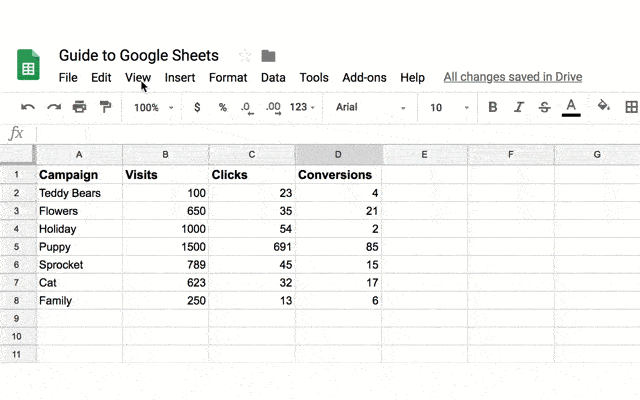
If you’re not used to spreadsheets, this useful online tool makes it easy to organize your content audit. This tool can help you:
- Tie together different data points from your content audit
- Let team members collaborate and comment on data
- Offers formulas and other tools to update critical metrics
If you’re not sure how to make the most of this tool, this guide to Google Sheets can help you get started.
Content Media Tools
8. Casted
Price: Contact sales for pricing on the Starter, Pro, and Enterprise plans.

Content audits aren’t just for blogs and web pages. Casted helps you understand how contacts are engaging with your podcast content. This can help you make actionable business decisions to drive engagement.
HubSpot customers: Casted integrates with Marketing Hub. You can use CRM tools to create lead capture forms to draw in your listeners for further nurturing.
9. Vidyard
Pricing: Free, with paid Pro and Business options

According to HubSpot research, 54% of companies plan to invest more in videos for TikTok this year, and another 56% are investing more in Instagram videos.
But no matter where you publish your videos, auditing your video content is essential, especially when trying to show ROI. Vidyard offers a comprehensive insights dashboard with visual analytics that you can use to audit your video content.
If you’re looking for more useful tools, this list of content marketing tools can help you organize and improve your content.
How to Do a Content Audit That Makes an Impact
You have the knowledge you need to perform content audits. You know how to create them, where to source them, and essentials to include. You’re fully prepared to use these audits in your organization for better content strategy and results. Give it a try, and use these tips to elevate your next campaign. Happy auditing!
Editor’s note: This post was originally published in September 2021 and has been updated for comprehensiveness.
MARKETING
Quiet Quitting vs. Setting Healthy Boundaries: Where’s The Line?

MARKETING
Microsoft unveils a new small language model

Phi-3-Mini is the first in a family of small language models Microsoft plans to release over the coming weeks. Phi-3-Small and Phi-3-Medium are in the works. In contrast to large language models like OpenAI’s ChatGPT and Google’s Gemini, small language models are trained on much smaller datasets and are said to be much more affordable for users.
We are excited to introduce Phi-3, a family of open AI models developed by Microsoft. Phi-3 models are the most capable and cost-effective small language models (SLMs) available, outperforming models of the same size and next size up across a variety of language, reasoning, coding and math benchmarks.
What are they for? For one thing, the reduced size of this language model may make it suitable to run locally, for example as an app on a smartphone. Something the size of ChatGPT lives in the cloud and requires an internet connection for access.
While ChatGPT is said to have over a trillion parameters, Phi-3-Mini has only 3.8 billion. Sanjeev Bora, who works with genAI in the healthcare space, writes: “The number of parameters in a model usually dictates its size and complexity. Larger models with more parameters are generally more capable but come at the cost of increased computational requirements. The choice of size often depends on the specific problem being addressed.”
Phi-3-Mini was trained on a relatively small dataset of 3.3 trillion tokens — instances of human language expressed numerically. But that’s still a lot of tokens.
Why we care. While it is generally reported, and confirmed by Microsoft, that these SLMs will be much more affordable than the big LLMs, it’s hard to find exact details on the pricing. Nevertheless, taking the promise at face-value, one can imagine a democratization of genAI, making it available to very small businesses and sole proprietors.
We need to see what these models can do in practice, but it’s plausible that use cases like writing a marketing newsletter, coming up with email subject lines or drafting social media posts just don’t require the gigantic power of a LLM.
Dig deeper: How a non-profit farmers market is leveraging AI
MARKETING
Navigating the Video Marketing Maze: Short-Form vs. Long-Form


Are you torn between using long-form or short-form videos for your small business marketing campaign? Well, you are not alone. Despite 89% of consumers wanting to see more brand videos, there is no one-size-fits-all answer about the ideal video length.
However, this should not deter you from creating an effective video strategy. In 2023, people watched an average of 17 videos per day, highlighting the influence of video content in today’s digital landscape.


Both short-form and long-form videos offer unique advantages and come with their set of challenges. Join me as I uncover the benefits and limitations of each video format to help you make informed marketing decisions.
What are Short-Form Videos?
Short videos typically range from 30 seconds to less than 10 minutes long. They are popular on social media platforms like TikTok, Instagram, Snapchat, and YouTube.
Short-form videos deliver brief yet engaging messages that quickly capture the viewer’s attention. Here are some popular types of short-form video content.
- TikTok Challenges
- Instagram Reels
- Snapchat Stories
- YouTube Shorts
- Twitter Video Ads
Benefits of Short-Form Videos
A previously cited report shows that 39% of marketers find short-form videos, ranging from 30-60 seconds long, more successful. The same study reports that 44% of customers prefer watching a short video to learn about a brand’s offerings.


So, it is evident that short-form videos have their benefits. Let’s take a closer look at some of them.
Attention-Grabbing
Short-form videos capture attention quickly, making them ideal for the fast-scrolling nature of social media platforms. Your audience is more likely to watch them in their entirety compared to longer content.
Cost-Effective Production
Creating short-form videos requires less time and resources compared to longer videos. As a small business owner with a limited budget, using short-form videos can be cost-effective.
Increased Engagement
Short-form videos engage viewers due to their crisp and concise nature. This results in more likes, comments, and shares that boost your content’s visibility and increase brand awareness.
Integrating short-form videos into your influencer marketing campaigns can further amplify your reach to new and diverse audiences.
Highly Shareable
Short videos are highly shareable. This makes it more likely for your viewers to share them, increasing their virality.


Want to get certified in Content Marketing?
Leverage the tools and channels to predictably and profitably drive awareness, leads, sales, and referrals—EVERYTHING you need to know to become a true master of digital marketing. Click Here
There are multiple benefits of adding video to your website including increased engagement, improved SEO, and enhanced user experience.
Limitations of Short-Form Videos
While short-form videos offer many advantages in content marketing, they also present some challenges.
Limited Message Depth
Due to their brief duration, short-form videos may struggle to convey complex or detailed messages. Longer videos might be more suitable if you need to communicate intricate information.
Competition for Attention
Standing out on platforms flooded with short-form video content can be challenging. You must create content that stands out to avoid becoming lost in the sea of other videos.
Shorter Lifespan
Short videos may lose their relevance with time. They can quickly get buried in users’ feeds, leading to a shorter visibility and engagement period than longer, evergreen content.
This means you must consistently create short-form videos to maintain audience interest over time.
Limited SEO Impact
Short-form videos may be more challenging to optimize for search engines than longer, more keyword-rich content. This can affect the discoverability of your content outside the social media scene.
What are Long-Form Videos?
Long-form videos are typically longer, ranging from a few minutes to several hours. They extend beyond a few minutes to several hours, providing ample time for in-depth topic exploration and detailed content.
These videos are particularly suitable for educational content, product demonstrations, and narrative-driven storytelling. Long-form videos are common on platforms like YouTube and Vimeo. Common types of long-form video content include:
- YouTube Series
- Webinars
- Educational Tutorials and Courses:
- Behind-the-Scenes Content
- Interviews and Conversations
Advantages of Long-Form Videos
Long-form video content is the fastest-growing segment, with videos above 30 minutes experiencing tremendous growth over the years. Let’s explore some of the benefits behind this growth.


Establishes Expertise and Credibility
Long-form videos allow you to provide in-depth information about various subjects, establishing your brand as an authority. Potential customers will likely trust and rely on your insights when you consistently deliver valuable content.
Builds Strong Audience Connections
The more your audience watches your videos, the more they become familiar with your content and brand. This consistent engagement promotes trust and loyalty, helping you create deeper connections with your audience.
Provide SEO Optimization Opportunities
Long-form videos keep your audience engaged for a longer duration than short ones. This signals search engines that your content provides value, resulting in higher rankings and increased visibility.
Besides, these videos provide opportunities to optimize for relevant keywords. This Attrock guide offers more insights into the value of SEO for your small business.
They Are Sustainable
Unlike short videos, well-produced and valuable long-form videos have an extended shelf life. They can continue to attract views and engagement over an extended period, contributing to a sustainable content strategy.
Instagram reels are also a part of short videos and you can get benefits from this platform by integrating it with your website. You can learn how to embed Instagram Reels on websites and get extra benefits from your Reels.
Drawbacks of Long-Form Videos
Despite their benefits, long-form videos also have certain limitations, including:
Attention Span Challenges
Between distractions, juggling tasks, and information overload, user attention span quickly diminishes. Viewers may lose interest and disengage from your long video before its conclusion.


Are You Ready to Master Social Media?
Become a Certified Social Media Specialist and learn the newest strategies (by social platform) to draw organic traffic to your social media sites.
Complex Production Process
Creating high-quality long-form videos requires more resources, including time, equipment, and skilled personnel. This can be disadvantageous, especially for small businesses with limited budgets.
Platform Limitations
Some social media platforms and video hosting sites may limit video length, making it challenging to distribute long-form video content. You may then be forced to repurpose your content to suit various platforms.
Short-Form or Long-Form Videos: Which Are Better?
Now that you know the benefits and limitations of each format, which one should you choose? Short-form or long-form videos?
Well, it all boils down to considering several factors, such as:
Content Objectives
What do you want to achieve from your video marketing campaign? Short-form videos are highly effective for quick brand exposure and generating buzz. Long-form videos, on the other hand, contribute to a more in-depth understanding of the brand.
Target Audience Preferences
Audiences with short attention spans likely prefer short-form videos, while long-form videos appeal to those seeking a more immersive experience.
Similarly, short-form videos may appeal more to younger audiences, while older demographics may prefer the depth of long-form content.
Platform Dynamics
Various platforms support different content formats. Short-form videos are well-suited for platforms like TikTok, Instagram, and Snapchat. On the other hand, platforms like YouTube and Vimeo are better for hosting longer videos.
Industry Type
Short-form videos would be ideal if your industry thrives on trends, entertainment, and quick messages. However, long-form videos are effective for industries requiring in-depth explanations or educational content.
Bottom Line
Ultimately, choosing short-form or long-form videos depends on your business’s specific needs and goals. Since both formats have advantages and limitations, making a choice may prove difficult.
However, it doesn’t have to be an uphill task. The key lies in recognizing when to incorporate each video format into your marketing strategy. Understanding your audience and its needs allows you to combine both formats strategically, maximizing the benefits of each.
Continuously analyze performance metrics and adapt your video marketing strategy accordingly to ensure optimal engagement and conversion rates.
-

 MARKETING6 days ago
MARKETING6 days agoEffective Communication in Business as a Crisis Management Strategy
-

 SEARCHENGINES6 days ago
SEARCHENGINES6 days agoGoogle Won’t Change The 301 Signals For Ranking & SEO
-

 SEO5 days ago
SEO5 days agobrightonSEO Live Blog
-

 PPC6 days ago
PPC6 days ago9 Ecommerce Trends to Boost Your Business in 2024
-

 SEO6 days ago
SEO6 days agoHow To Write ChatGPT Prompts To Get The Best Results
-

 SEO4 days ago
SEO4 days agoGoogle March 2024 Core Update Officially Completed A Week Ago
-

 WORDPRESS4 days ago
WORDPRESS4 days ago9 Best WooCommerce Multi Vendor Plugins (Compared)
-
SEARCHENGINES5 days ago
Daily Search Forum Recap: April 25, 2024



















You must be logged in to post a comment Login